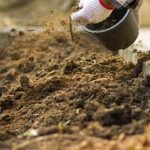Pressure treated lumber is a commonly used material in construction projects due to its durability and resistance to rot and pests. However, many gardeners may be wondering if it is safe to use pressure treated lumber in their vegetable gardens. In this article, we will explore the benefits and potential risks of using pressure treated lumber in vegetable gardens, as well as provide tips for safe gardening practices.
Using pressure treated lumber in vegetable gardens has its advantages. The chemical treatment used on the wood helps extend its lifespan, making it a cost-effective choice for gardeners. Additionally, the resistance to rot and pests ensures that the wood will withstand the elements and maintain its structure over time. However, there are also concerns surrounding the use of pressure treated lumber in contact with soil that will be used to grow edible plants.
Some potential risks include chemicals leaching into the soil and potentially impacting plant health or the safety of consuming vegetables grown in contact with pressure treated wood. It is crucial for gardeners to understand the process of pressure treatment and how it may affect their gardens. Identifying pressure treated lumber through labels or markings is vital to ensure proper handling and minimize any potential risks.
In this article, we will delve deeper into understanding the pressure treatment processes, discussing best practices for using pressure treated lumber in vegetable gardens, exploring alternative materials, and providing tips for safe gardening practices with pressure treated lumber. By considering both the benefits and risks outlined in this article, readers can make an informed decision on whether or not to incorporate pressure treated lumber into their own vegetable gardens.
Benefits of Using Pressure Treated Lumber in Vegetable Gardens
Enhanced Durability and Resistance
One of the primary benefits of using pressure treated lumber in vegetable gardens is its enhanced durability and resistance to rot, decay, and pests. The pressure treatment process infuses chemicals into the wood, creating a barrier that protects it from damage caused by moisture, insects, fungi, and other environmental factors. As a result, pressure treated lumber can withstand the elements and maintain its structural integrity for a longer period compared to untreated wood.
Cost-Effective Choice
Treating lumber with chemicals not only enhances its lifespan but also makes it a cost-effective choice for gardeners. By utilizing pressure treated lumber in vegetable gardens, gardeners can avoid frequent replacement or repairs of wooden structures. This longevity ultimately saves money in the long run by reducing expenses associated with buying new materials or investing in alternative solutions.
Availability
Another advantage of using pressure treated lumber in vegetable gardens is its wide availability. Pressure treated lumber is commonly found at local home improvement stores or garden centers, making it easily accessible to gardeners who are planning construction projects or upgrading their existing garden structures. This accessibility ensures that gardeners have access to a reliable and durable material option for their vegetable gardens.
Overall, using pressure treated lumber in vegetable gardens provides several benefits including enhanced durability, resistance to rot and pests, cost-effectiveness, and ready availability. These advantages make it an appealing choice for gardeners looking to construct long-lasting structures or beds within their vegetable gardens. However, it is essential to consider the potential risks associated with pressure treated lumber and take necessary precautions to ensure the safety of plants and human health.
Potential Risks and Concerns
When considering the use of pressure treated lumber in vegetable gardens, it is important to be aware of potential risks and concerns. One major concern is the leaching of chemicals from the treated wood into the surrounding soil. The chemicals used in pressure treatment, such as chromated copper arsenate (CCA) or alkaline copper quaternary (ACQ), can potentially contaminate the soil over time.
This contamination raises questions about the impact on plant health and the safety of consuming vegetables grown in contact with pressure treated wood. The chemicals can be absorbed by plants and accumulate in their tissues, leading to potential health risks for humans when these vegetables are consumed.
To address these concerns, it is recommended to take precautionary measures when using pressure treated lumber in vegetable gardens. One effective measure is to create a barrier between the wood and the soil by using a plastic lining or geotextile fabric. This physical barrier serves as a protective layer, preventing direct contact between the wood and the soil where leaching may occur.
Another option is to consider alternatives to pressure treated lumber. There are naturally rot-resistant woods available in the market that can serve as safer options for vegetable garden construction. Additionally, raised garden bed kits specifically designed for growing edibles often utilize materials that are safe for organic gardening practices.
While there are potential risks associated with pressure treated lumber use in vegetable gardens, taking proper precautions can help mitigate these concerns. It is crucial to weigh both the benefits and risks before deciding whether to use pressure treated lumber, ensuring that you make an informed choice for your garden’s wellbeing.
Understanding Pressure Treatment Processes
Pressure treated lumber is a common choice for construction projects due to its durability and resistance to rot and pests. When it comes to using pressure treated lumber in vegetable gardens, it is important to understand the pressure treatment processes involved. This section will explain the different methods of pressure treating lumber, including the types of chemicals used and their potential effects on plants and human health.
Methods of Pressure Treatment
There are two main methods used for pressure treating lumber: waterborne solutions and oilborne preservatives. Waterborne solutions use water as a carrier for the chemicals, while oilborne preservatives use petroleum-based solvents. The most commonly used chemicals in pressure treatment include chromated copper arsenate (CCA), alkaline copper quat (ACQ), and copper azole (CA). Each chemical has different properties and levels of toxicity.
Effects on Plants and Human Health
While pressure treated lumber is effective in preventing rot and pests, there are concerns about the leaching of chemicals into the soil and its potential impact on plant health. The chemicals used in pressure treating wood can potentially be taken up by plant roots, which may affect their growth or even pose a risk to human health when consuming vegetables grown in contact with the wood.
However, studies have shown that the amount of chemicals leached from properly installed and maintained pressure treated lumber is generally minimal. It is important to note that the risk may vary depending on factors such as soil type, pH levels, rainfall patterns, and specific chemical formulations. Additionally, some newer formulations of pressure treated lumber use alternative compounds that are considered environmentally friendly.
Identifying Pressure Treated Lumber
To ensure safe gardening practices, it is essential to be able to identify whether a piece of wood has been pressure treated or not. Pressure treated lumber typically has distinct markings or labels indicating its treatment status. Look for stamps or tags specifying “CA-C,” “ACQ,” or “MCQ” for copper-based treatments, or “ACZA” for compounds that combine copper with zinc. These labels indicate that the wood has been treated to resist rot and pests.
Understanding the pressure treatment process and its potential effects on plants and human health is crucial in making informed decisions when using pressure treated lumber in vegetable gardens. By being aware of the specific chemicals used, their leaching potential, and how to properly identify treated wood, you can safely utilize this material while minimizing risks.
Best Practices for Using Pressure Treated Lumber in Vegetable Gardens
When using pressure treated lumber in vegetable gardens, there are several best practices that can help minimize potential risks and ensure the safety of your plants and produce. Consider implementing the following precautions:
- Use a barrier: One effective measure is to use a barrier between the pressure treated wood and the soil. Options include placing a plastic lining or using geotextile fabric. This barrier will help prevent direct contact between the wood and the soil, reducing the chances of chemicals leaching into the garden.
- Choose natural rot-resistant options: If you have concerns about using pressure treated lumber, consider alternative materials that are naturally resistant to rot. Woods such as cedar and redwood are excellent choices for vegetable gardens as they do not require chemical treatment to resist decay.
- Raised garden bed kits: Another option is to use raised garden bed kits specifically designed for growing edibles. These kits often use untreated woods like cedar or composite materials, providing a safe environment for your vegetables while minimizing contact with pressure treated wood.
It is important to note that even when following these best practices, regular monitoring is crucial. Keep an eye out for any signs of deterioration in the pressure treated wood, such as splintering or cracking, as this can increase the risk of chemical leaching. Additionally, consider sealing or coating the wood periodically to further protect it from degradation.
If you choose to use pressure treated lumber in your vegetable garden, it is recommended to conduct regular soil testing. This will help ensure that any potential chemical leaching does not pose a risk to your plants or compromise their safety when consuming the harvested produce.
By following these best practices, you can minimize potential risks associated with using pressure treated lumber in your vegetable garden while still benefiting from its durability and resistance to pests and decay.
Other Uses for Pressure Treated Lumber in the Garden
Pressure treated lumber is not just limited to its use in vegetable gardens. It can be employed in various other areas of the garden to provide durability and resistance to rot, even when subjected to harsh outdoor conditions. Here are some other uses for pressure treated lumber in the garden:
- Building Trellises: Trellises are essential structures for supporting climbing plants like cucumbers, tomatoes, and beans. Pressure treated lumber can be used to construct sturdy trellises that will withstand the weight of these plants as they grow and bear fruit. The resistance to rot ensures that the trellis will have a longer lifespan.
- Creating Pathways: Incorporating pathways into your garden design not only provides convenience but also adds visual appeal. Pressure treated lumber can be used to build pathways by creating wooden stepping stones or planks. These pathways can endure heavy foot traffic and withstand exposure to moisture, ensuring durability over time.
- Constructing Raised Beds: Raised beds are a popular choice for many gardeners as they provide better control over soil quality and drainage while reducing weed growth. Pressure treated lumber, when properly sealed or coated, can be used to construct raised beds that will last for several years without succumbing to rot or decay.
- Building Garden Furniture: If you’re looking to add seating or lounging areas in your garden, pressure treated lumber can be an excellent material choice for building garden furniture such as benches, chairs, or tables. Its durability allows it to withstand constant exposure to the elements without deteriorating quickly.
When using pressure treated lumber in these non-edible gardening applications, it’s important to follow safety precautions such as sealing or coating the wood and avoiding direct contact with bare skin during handling. Regular monitoring should also be done for any signs of deterioration, especially if the wood is exposed to constant moisture.
While pressure treated lumber provides several benefits in the garden, it’s essential to consider the potential risks and precautions associated with its use. Gardeners should weigh the benefits and risks before making a decision on whether or not to use pressure treated lumber in their gardening projects. Exploring alternative materials like naturally rot-resistant woods or composite lumber can also be considered for those who prefer to avoid using pressure treated wood altogether.
Popular Alternatives to Pressure Treated Lumber
When it comes to building vegetable gardens, pressure treated lumber is a commonly used material due to its durability and resistance to rot and pests. However, concerns about the potential leaching of chemicals into the soil and the safety of consuming vegetables grown in contact with pressure treated wood have prompted many gardeners to seek alternative materials. In this section, we will discuss some popular alternatives to pressure treated lumber for vegetable gardens.
One popular alternative is cedar wood. Cedar is naturally resistant to rot and insects, making it a suitable choice for garden construction projects. It also has a pleasing aroma and can add visual appeal to your garden. Redwood is another excellent alternative that offers similar benefits. Both cedar and redwood are durable, weather-resistant, and can withstand the elements without the need for chemical treatment.
Composite lumber is another option for those looking for an eco-friendly alternative to pressure treated lumber. Made from a combination of recycled wood fibers and plastic, composite lumber offers excellent durability without the need for chemical treatments or staining. It is also resistant to rotting, splintering, and cracking.
| Alternative | Durability | Cost | Eco-friendliness |
|---|---|---|---|
| Cedar Wood | Durable | Higher initial cost but long lifespan | Natural and renewable resource |
| Redwood | Durable | Higher initial cost but long lifespan | Natural and renewable resource |
| Composite Lumber | Durable | Higher initial cost but low maintenance | Made from recycled materials |
Before choosing an alternative to pressure treated lumber, it is crucial to consider your budget, the longevity of the material, and its environmental impact. Additionally, ensure that the chosen material is safe for vegetable gardens and does not contain any harmful chemicals or treatments. By making an informed decision and selecting an appropriate alternative, you can create a safe and sustainable garden for growing your own vegetables.
Tips for Safe Gardening with Pressure Treated Lumber
Pressure treated lumber is a popular choice for construction projects due to its durability and resistance to rot and pests. However, when it comes to using pressure treated lumber in vegetable gardens, there are some potential risks and concerns that gardeners should be aware of. In this section, we will discuss some tips for safe gardening with pressure treated lumber to minimize these risks.
Firstly, it is important to handle pressure treated lumber with care. When cutting or sanding the wood, wear protective gloves and a mask to avoid direct contact with any chemicals that may be present. It is also recommended to seal or coat the wood after installation, as this can help prevent any chemicals from leaching into the soil.
To further reduce the risk of chemical leaching into the soil, consider using a barrier between the pressure treated lumber and the soil. This can be achieved by placing a plastic lining or geotextile fabric underneath the wood before adding soil. Not only does this provide an extra layer of protection, but it can also help improve drainage in raised beds.
Regular monitoring of pressure treated lumber is crucial in ensuring its safety for gardening purposes. Inspect the wood regularly for any signs of deterioration, such as cracking or splitting. If any areas of concern are detected, it is advised to replace those sections promptly to avoid potential exposure to harmful chemicals.
By following these tips for safe gardening with pressure treated lumber, gardeners can enjoy the benefits of its durability while minimizing potential risks. However, it’s important to note that alternative solutions exist for those who prefer not to use pressure treated lumber in their vegetable gardens. In the next section, we will explore popular alternatives and discuss their pros and cons in more detail.
Conclusion
In conclusion, the use of pressure treated lumber in vegetable gardens presents both benefits and risks that gardeners should carefully consider. On one hand, pressure treated lumber offers durability, resistance to rot and pests, and cost-effectiveness due to its extended lifespan. These advantages make it an appealing choice for many gardeners looking for a long-lasting material to construct their raised beds or garden structures.
However, there are potential risks associated with using pressure treated lumber in vegetable gardens. The leaching of chemicals into the soil is a primary concern as it may impact plant health and raise safety concerns about consuming vegetables grown in contact with the wood. Understanding the pressure treatment processes can help gardeners make informed decisions by considering the type of chemicals used and their potential effects on plants and human health.
To minimize potential risks, precautionary measures such as using a barrier between the wood and soil can be taken. Additionally, alternative solutions like naturally rot-resistant woods or raised garden bed kits specifically designed for growing edibles can be considered. Gardeners should also be aware of other uses for pressure treated lumber in non-edible gardening applications where its benefits may outweigh the risks.
Frequently Asked Questions
Is pressure treated lumber OK for vegetable gardens?
Pressure treated lumber is generally not recommended for vegetable gardens. This type of wood is treated with chemicals, such as arsenic, which can leach into the soil over time and potentially be absorbed by the plants.
Although newer pressure treated lumber may use safer alternatives, it is still best to err on the side of caution when it comes to growing edible plants. Instead, opt for natural untreated wood or other materials that are known to be safe for vegetable gardening.
Is pressure treated wood OK for vegetable beds?
Similar to pressure treated lumber, using pressure treated wood for vegetable beds is not advised. The chemicals used in the treatment process can potentially contaminate the soil and affect the quality and safety of the vegetables grown in those beds.
It’s important to prioritize the health and well-being of your plants by choosing untreated wood or alternative materials for constructing your vegetable beds.
What wood should not be used in a raised garden bed?
There are a few types of wood that should generally be avoided when building raised garden beds. One example is cedar that has been treated with creosote or other chemicals used for preserving railroad ties or utility poles. These chemicals have toxic properties that can seep into the soil and harm plant roots, thus compromising the safety and overall health of your garden.
Additionally, avoid using woods that are prone to rotting quickly, such as pine or fir, as they may not have a long lifespan in an outdoor setting and could deteriorate faster than desired. Opting for durable and naturally resistant woods like redwood or cedar (without chemical treatments) would be a better choice to ensure longevity and promote a healthy growing environment for your raised garden bed.

If you’re looking to get into vegetable gardening, or are just looking for some tips on how to make your current garden better, then you’ve come to the right place! My name is Ethel and I have been gardening for years. In this blog, I’m going to share with you some of my best tips on how to create a successful vegetable garden.





